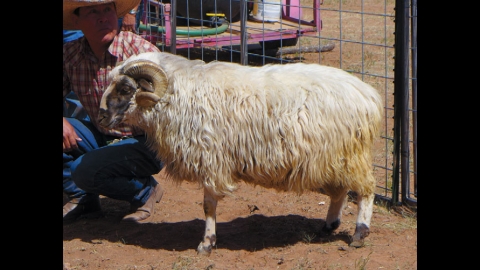Bringing Churro Sheep Back from the Brink of Extinction
The churro lamb is the ancient breed of sheep that has sustained Navajo, Hispanic and Pueblo people for 400 years. For the Navajo it has a particular spiritual significance reflected in their creation stories, but by the 1970s only a few animals remained.
First there was Kit Carson’s war, a scorched-earth campaign in the 1860s, that killed off flocks, burned orchards and crops and ended in the relocation of the Navajo to Bosque Redondo, New Mexico. When the surviving Navajo returned to their home lands, government agents introduced other breeds of sheep such as Merino, Rambouillet, Lincoln, Hampshire, Cotswold, Suffolk and Scottish Black Face, which provided more meat per animal for food. But these breeds had short-fibered, crimped and oily fleeces that required lots of water to process, and were unsuitable for hand weaving. The introduced breeds from Europe were also less adapted to the rough, arid canyons and mesas of the Colorado Plateau.
Later, during the Dust Bowl of the 1930s, US government stock reduction policies and cultural reform all but wiped out the remains of the hardy, multi-purpose sheep which had provided meat, milk, hides and fiber for weaving clothing, blankets and rugs—everything that Navajo families needed to survive.
Alarmed by the potential loss of this culturally and biologically important heritage livestock animal, a fate which befell the bison, a grass roots effort was launched in the 1970s to save the Navajo-Churro sheep. A few traditional elder Navajos who remembered the breed, and a group of New Mexico weavers joined with animal sciences professor Dr. Lyle McNeal at Utah State University and a handful of individuals and organizations to find ways to save and re-introduce the breed to the Pueblo and Navajo people. Searching for genetic stock and the few surviving Navajo-Churro sheep to start a long-term breeding program was a difficult, multi-decade effort.
Today the sheep has made a remarkable comeback, and is no longer at risk of disappearing. There is an official registry of pure-bred sheep maintained by the Navajo-Churro Sheep Association; the Navajo Sheep Project breeds and distributes Navajo-Churro sheep to Navajo families. Diné be´iiná (DBI, or Navajo Lifeways), a Navajo run nonprofit, works to raise awareness of this distinctive ancestral breed, to increase the number of Navajo-Churro flocks and improve their genetics and to educate youth about weaving and other traditions associated with the sheep and pastoral life. A dedicated group of young Navajos have formed the Youth Fiber Artists project to teach weaving skills and develop a fiber arts cottage industry, and a number of breeders are working with much success in developing strong genetics and stock for sale.
In 2006 Slow Food’s Foundation for Biodiversity recognized the breed as one of distinctive gastronomic quality and cultural importance. This resulted in the establishment of a “presidium,” a collective of sheepherders who agree to raise the animals by a strict protocol. This includes free-range grazing and antibiotic-free and corn-free organic feeding. The result is a lean meat with a deep herbaceous, sweet flavor that reflects the sage, wild grasses, bushes and native forage of the landscape—what gastronomes refer to as “terroir.” Slow Food supports a coordinated effort to niche-market the meat to chefs, CSAs and specialty stores, as well as to outlets on the Navajo Nation, such as Diné College. Its goal is to create a better livelihood for weavers and herders, and tell the remarkable story of revival to consumers who take interest in the origins and healthfulness of their food.
For further reading: navajosheepproject.com/churrohistory.html







